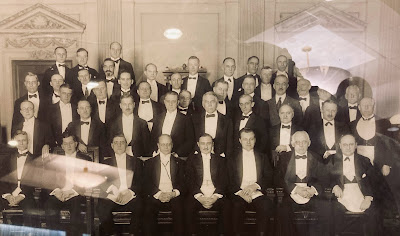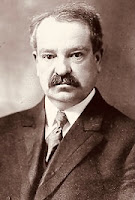It was a hundred years ago today, at this very hour in fact, that my lodge was made legal by the Grand Lodge of New York.
On the evening of Monday, October 30, 1922, inside the Grand Lodge Room of Masonic Hall, Publicity Lodge 1000 was constituted and its officers installed by a ritual team consisting of Grand Master Arthur S. Tompkins, Deputy Grand Master William A. Rowan, Senior Grand Warden Meyer B. Cushner, Junior Grand Warden Terry M. Townsend, Grand Treasurer Jacob C. Klick, Grand Secretary Robert H. Robinson, Grand Chaplain Oscar F. Trader, and Grand Marshal John J. MacCrum.
 |
| The first meeting Under Dispensation, Thursday, December 29, 1921. |
The lodge was organized by advertising and other media professionals. According to legend, a number of them were acquainted professionally and socially (maybe through the Advertising Club of New York), but it was some time before they realized many in the group were Freemasons. Upon that discovery, they set about organizing a lodge. Grand Master Robert H. Robinson issued the Dispensation, and the first meeting U.D. was held Thursday, December 29, 1921.
It is unsurprising Publicity’s birth was covered by trade publications serving the publishing world. The November 4, 1922 edition of The Fourth Estate newspaper reported:
An interesting event in advertising circles was the constitution of Publicity Lodge No. 1000 F&AM on October 30.
 |
| Arthur S. Tompkins |
There was a large attendance of Masons from other lodges. The ceremony was simple but impressive. St. Cecile quartet furnished the music. Addresses were made by the Past Grand Master Robert H. Robinson, and on George Washington as a Mason by Grand Master Tompkins. The Master and a delegation from St. Nicholas Lodge presented the new lodge with a handsome ballot box. Several charter members of Publicity came from St. Nicholas.
 |
| Our original VSL. |
Herman G. Halsted, of Paul Block, Inc., is Master.
John H. Baumann, of Stevens & Baumann, is Senior Warden.
Louis W. Bleser, of Charles C. Green Advertising, is Treasurer.
George French is Secretary.
The November 11, 1922 issue of Editor & Publisher reported:
The ceremony of constitution was attended by many Masons from other New York lodges, and visitors from abroad, including the Past Grand Master of Masons of Nova Scotia. The Master of Saint Nicholas Lodge No. 321, accompanied by a delegation of members, was present and presented Publicity with a handsome ballot box.
E&P also included Publicity among its Ad Clubs and Associations listings.
 |
| Herman G. Halsted |
How did Publicity grab the Number 1000, the huge milestone and a most memorable cardinal number? It’s not exactly a sequential lodge number. Bay Side Lodge 999 was constituted on May 9, 1922; St. Mark’s Lodge 1001 somehow was constituted the day before that; and Lodge 1000 received its warrant nearly six months later! For a fraternity that inculcates study of Arithmetic among the Liberal Arts and Sciences, this appears amiss.
Publicity Lodge lore explains that because the Roman numeral M equals our number 1000, it was planned for us to receive that number. What’s so great about M? In advertising copy writing, the copy writer adds an M at the end of his copy, center page, to inform the editor there is nothing more to read. (How the advertising business chose M for that purpose may be unknown today.)
And speaking of writing and editing, MW Tompkins also advanced the idea of an official periodical for New York Masons. It would be titled The New York Masonic Outlook. This was a novel idea as grand lodges did not have in-house magazines for their members, but in the 1920s, all things became possible. Masonic membership in the United States surged during and after World War I and through the twenties, reaching 3.5 million before the disaster of the Great Depression. The multitudes of Master Masons resulted in lodges proliferating coast to coast. More real estate was acquired and developed. More charities were established. The appendant bodies flourished. Supporting industries providing regalia, paraphernalia, and other goods profited. There was more of everything, so there was money to establish a magazine for New York Freemasonry too.
It didn’t take Grand Lodge long to hire the best available editor to bring the Outlook to fruition. Harry LeRoy “H.L.” Haywood (1886-1956) was among the top Masonic authors whose books are valued for their clear prose to help the reader grasp Masonry’s sometimes arcane and vexing subjects. He also was renowned for editing The Builder, published by the National Masonic Research Society, that was not only a magazine, but was the centerpiece of a correspondence course in Masonic education. Haywood arrived in New York and, seeking the most talented available help in starting a magazine from scratch, he affiliated with—who else?—Publicity Lodge 1000.
Because the world outside has changed in infinite ways since 1922—people then could not comprehend what we today take for granted—it is especially appreciated how Publicity Lodge remains mostly unchanged. Our styles of dress and appearance evolved, and even our ritual has been altered a little, but our sacred retreat of friendship and virtue steadfastly upholds the meaning of Masonry. Here’s to another hundred years!
M


I was a member of Publicity Lodge 1000 around a decade ago and I didn’t know much of what you’ve written here so thank you for the information.
ReplyDeleteMaybe you could come back one day.
Delete